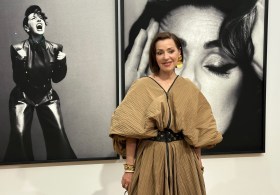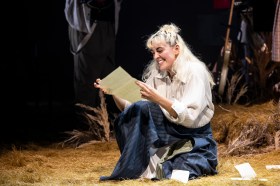Image: A Doll’s House presented by State Theatre Company.
In an interview before the premiere of State Theatre Company’s production of a modernised adaptation of Henrik Ibsen’s famous play A Doll’s House, director Geordie Brookman said, ‘We all know the classics, so we need to see them fractured and broken and reinterpreted.’
His lap-dancing, head-banging, adaptation of Henrik Ibsen’s famous play A Doll’s House is a flawed and incongruous production that suggests that this director should focus more on producing quality drama instead of indulging in ideological exercises.
Ibsen’s well-crafted play is one of the most performed plays of the past 150 years because, despite its 19th century origins and setting, it is a very relatable play. Audiences, it would seem, are able to enjoy a play from another era and setting and appreciate its meaning, its importance and its continued relevance.
The plot is simple – Nora, a bubbly young wife and mother, secretly commits fraud to pay for her husband Torvald’s rehabilitation. When Krogstad attempts to reveal the fraud Nora’s life spirals out of control. The plot alterations made to modernise the play only serve to increase confusion and lessen the credibility of the characters and their actions. And to further add to the implausibility of this modernised production, the characters, despite being ostensibly Australian, have retained their 19th Century Norwegian names such as Torvald and Krogstad. Considering that Ibsen’s play has been altered in so many ways, including obvious and hardly amusing Donald Trump jokes, changing incongruous, anachronistic names would seem appropriate. But this is just another example of how this adaptation just doesn’t work.
As with many of Brookman’s productions actors not required in a scene, who would ordinarily be off-stage, remain on-stage sitting motionless. The distraction caused by this style-over-substance directing quirk is exaggerated in this production because almost all of the dialogue occurs on a large carpeted dais in the middle of the stage; therefore when a performer silently makes their way to the dais not only do they draw attention away from the scene in progress their advance unnecessarily telegraphs, to some extent, what is going to happen next.
Throughout the first two acts the dais, and a portion of the stage, slowly rotates, requiring the actors to move chairs or alter their position so that the rotation doesn’t leave them with their backs to the audience. Why does it rotate? Who knows? Most likely, this mechanical device is used for the same reason Edmund Hillary gave for climbing Everest. This device is used so often in State Theatre Company productions that its appearance has become a cue to drink as part of a drinking game among regular patrons.
It is not clear what inspired Geoff Cobham’s blue and orange set but it is arguable the setting and the content of the play played little part. The combination of 1970s décor, scaffolding and school chairs contrasted with the new text’s modern Australian domestic setting.
Dale March struggles to make Torvald anything other than a caricature. It is arguable that the ever-reliable Nathan O’ Keefe, who portrays family friend Dr Rank, would have made a better Torvald. Miranda Daughtry’s portrayal of Nora is two-dimensional and often shrill.
At over two hours and 40 minutes the production is overlong; Nora’s pivotal dance scene was unnecessarily extended, and the play would benefit from the removal of the other musical scenes.
State Theatre Company’s first ever production of A Doll’s House resembles the naive Nora of Act 1; while Nora is beholden to sweets and money this production is blinded by facile staging gimmicks, dance music and cheap laughs. By staging this clumsy, unfulfilling adaptation of the classic play two opportunities have been lost; the South Australian public are being denied the opportunity to experience one of the greatest plays of all time, as it was written, and at the same time they are also being denied an opportunity to view an original, unfettered, modern, Australian play exploring similar themes.
Rating: 2 stars out of 5
A Doll’s House
By Henrik Ibsen
New Adaptation by Elena Carapetis
Director: Geordie Brookman
Set & Lighting Designer: Geoff Cobham
Costume Designer: Ailsa Paterson
Composer: Alan John
Cast: Rachel Burke, Miranda Daughtry, Rashidi Edward, Dale March, Nathan O’keefe and Anna Steen
Dunstan Playhouse, Adelaide Festival Centre
Season concluded





